Artisten is a German circus movie from 1934 to 1935 starring Susi Lanner, Hans Junkermann, Hilde Hildebrand and Harry Piel, who also acted as director. The screenplay was written by Max W. Kimmich after the silent movie The secret of the circus Barré.
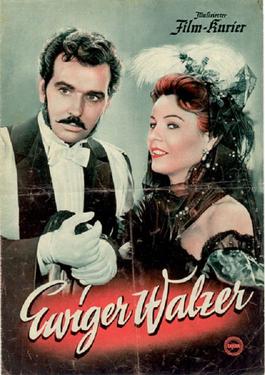
The Eternal Waltz is a 1954 West German drama film dramatizing the life of Johann Strauss II. The initial story was written by Hanns Marschall and Ruth Charlotte Silbermann, and the film itself was written by Alexander Lix; the adaptation was by Paul Verhoeven who also directed the film.

The Three from the Filling Station is a 1955 West German musical film directed by Hans Wolff and starring Adrian Hoven, Walter Müller and Walter Giller. It was shot at the Tempelhof Studios in West Berlin and on location around the city. The film's sets were designed by the art directors Kurt Herlth and Hans Kuhnert.
Friedl Hardt was a German actress.
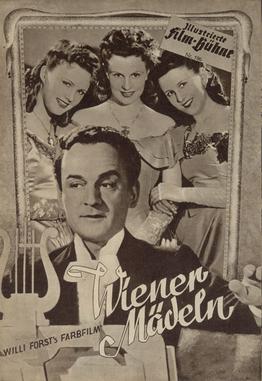
Viennese Girls is a 1945 historical musical film directed by Willi Forst and starring Forst, Anton Edthofer and Judith Holzmeister. The film was made by Wien-Film, a Vienna-based company set up after Austria had been incorporated into Greater Germany following the 1938 Anschluss. It was the third film in Forst's "Viennese Trilogy" which also included Operetta (1940) and Vienna Blood (1942). The film was finished in 1945, during the closing days of the Second World War. This led to severe delays in its release, which eventually took place in 1949 in two separate versions. One was released by the Soviet-backed Sovexport in the Eastern Bloc and the other by Forst.
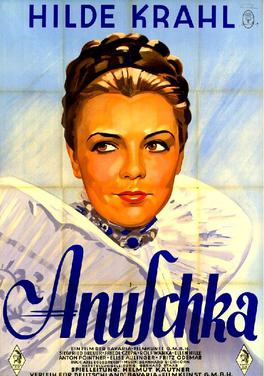
Anuschka is a 1942 German historical drama film directed by Helmut Käutner, and starring Hilde Krahl, Siegfried Breuer and Friedl Czepa. It was shot at the Barrandov Studios in Prague and Cinecitta in Rome. Location filming took place in Carinthia. The film's sets were designed by art director Ludwig Reiber.

The War of the Oxen is a 1943 German historical film directed by Hans Deppe and starring Elfriede Datzig, Paul Richter and Wastl Lichtmanegger. It is an adaptation of Ludwig Ganghofer's 1914 novel of the same title.

Nanon is a 1924 German silent historical film directed by Hanns Schwarz and starring Agnes Esterhazy, Harry Liedtke, and Hanni Weisse. It is based on the operetta Nanon by Richard Genée with a libretto by F Zell. The film's sets were designed by the Hungarian art director Stefan Lhotka. The film was remade in 1938 as a sound film of the same name.
The Dealer from Amsterdam is a 1925 German silent film directed by Victor Janson and starring Werner Krauss, Hilde Hildebrand and Harry Hardt. It was made by the German subsidiary of the Fox Film Company.
The Man in the Saddle is a 1925 German silent film directed by Manfred Noa. It was remade as a sound film of the same title starring Harry Piel.

Silence in the Forest is a 1937 German drama film directed by Hans Deppe and starring Hansi Knoteck, Paul Richter and Gustl Gstettenbaur.

Manolescu is a 1929 German silent film directed by Viktor Tourjansky and starring Ivan Mozzhukhin, Brigitte Helm and Heinrich George. It was shot at the Babelsberg Studios in Berlin and on location in St. Moritz and Monte Carlo. The film's sets were designed by the art directors Robert Herlth and Walter Röhrig.

Jumping Into the Abyss is a 1933 German crime film directed by Harry Piel and starring Piel, Elga Brink and Anton Pointner.

The Saint and Her Fool is a 1935 German drama film directed by Hans Deppe and Paul May and starring Friedrich Ulmer, Lola Chlud and Hansi Knoteck.

The Road to Paradise is a 1956 French-German romantic comedy film directed by Willi Forst and Hans Wolff and starring Georges Guétary, Christine Carère and Claude Farell. The film is the French version of the 1955 German film The Three from the Filling Station, which was itself a remake of a 1930 film.
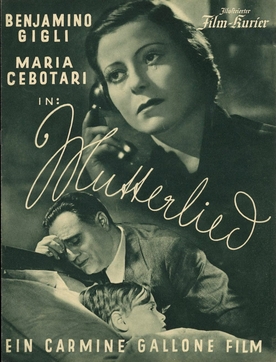
Mother Song is a 1937 German-Italian musical drama film directed by Carmine Gallone and starring Beniamino Gigli, Maria Cebotari and Hans Moser. It was produced by Itala Film, a Berlin-based production company with strong links to Italy.
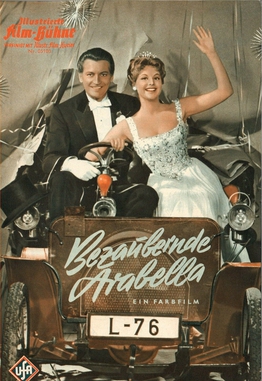
Adorable Arabella is a 1959 West German comedy film directed by Axel von Ambesser and starring Johanna von Koczian, Carlos Thompson and Hilde Hildebrand. It is an adaptation of the 1949 novel Arabella by Georgette Heyer.

Between Heaven and Earth is a 1934 German historical drama film directed by Franz Seitz and starring Rudolf Klein-Rogge, Heinz Klingenberg, Attila Hörbiger and Karin Hardt. It was shot at the Bavaria Studios in Munich. The film's sets were designed by the art director Max Seefelder. It is based on the 1856 novel of the same title by Otto Ludwig which was subsequently remade as a 1942 film.
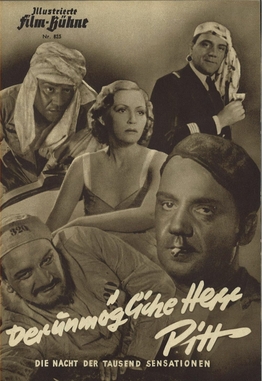
The Impossible Mister Pitt is a 1938 German adventure crime film directed by and starring Harry Piel. It also features Willi Schur, Leopold von Ledebur and Hilde Weissner. It was shot at the Babelsberg Studios in Berlin and on location off the coast of Split in Croatia. The film's sets were designed by the art directors Otto Erdmann and Hans Sohnle. It was based on the novel of the same title by Georg Mühlen-Schulte who also worked on the screenplay.
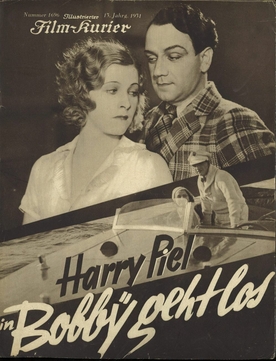
Bobby Gets Going is a 1931 German comedy action film directed by and starring Harry Piel and also featuring Annie Markart, Hilde Hildebrand and Kurt Lilien. It was shot at the EFA Studios in Halensee and on location around Berlin including at the Sportpalast. The film's sets were designed by the art director Gustav A. Knauer. It was based on a 1926 novel by Georg Mühlen-Schulte. It was distributed by the German branch of Universal Pictures.
















